engine SKODA SUPERB 2007 1.G / (B5/3U) Workshop Manual
[x] Cancel search | Manufacturer: SKODA, Model Year: 2007, Model line: SUPERB, Model: SKODA SUPERB 2007 1.G / (B5/3U)Pages: 259, PDF Size: 14.71 MB
Page 179 of 259

Taking care of your vehicle and cleaning the vehicle
178
Engine compartment
Good corrosion protection is very importan t, particularly in winter when one often
drives over its salt-strewn roads. One should therefore clean the entire engine
compartment before and after the salt spreading period, in order to prevent the salt
from being destructive.
Škoda Service Partners have the cleani ng agents recommended by the manufac-
turer and also the required equipment.
WARNING
•It is necessary to observe the guidelines given in the chapter before
working on the engine compartment ⇒page 185.
•Let the engine cool down before cleaning the engine compartment.
Caution
•Engine cleaning may be only be und ertaken when the ignition is off.
•It is recommended to cover the generator before washing the engine compart-
ment.
For the sake of the environment
The dirty water produced by washing the engine has washed away petrol, and resi-
dues of grease and oil and should therefor e be cleaned by an oil separator. This is
why engine washing should only be undertaken in a garage or at a fueling station
(when these are fitted with the required equipment).
Care of the interior of vehicle
Plastic parts, artificial leather and cloths
You can clean plastic parts and artificial leather with a moist cloth. You should only
treat such parts with special solvent-free plastic cleaning and care products it
does prove to be adequate. Upholstery cloth and cloth trim on the
doors, luggage compartment cover, head-
liner etc. are best treated with special cleaning products, using if necessary a dry
foam and a soft sponge or brush.
We recommend using a cleaning product from Škoda genuine accessories offered
by your Škoda dealer.
Caution
Solvent-free cleaners attack the material and can damage it.
Fabric covers of electrically heated seats
Do not clean the seat covers moist as this may result in damage to the seat heating
system.
Clean such covers using special agents, for example dry foam.
Natural leather
Natural leather requires quite particular care and attention.
Leather should be treated from time to time according the following
guidelines depending on how much it is used.
Normal cleaning
– Clean soiled areas of the leather with slightly moistened cotton or
woollen cloth.
Severe soiling
– Clean severely soiled areas with a cloth dipped in a mild soapy solu- tion (2 spoonfuls of natural soap to 1 litre of water).
– Ensure that the leather is not soaked through at any point and that no water gets into the stitching of the seams.
– Dry off the leather with a soft, dry cloth.
NKO B5 20.book Page 178 Friday, March 2, 2007 1:46 PM
Page 182 of 259
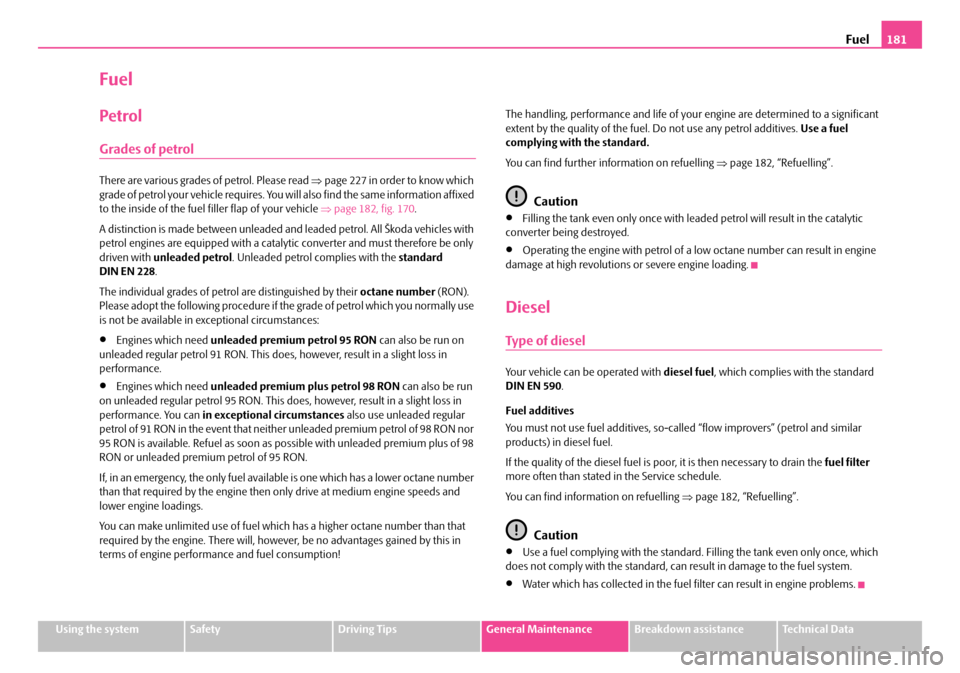
Fuel181
Using the systemSafetyDriving TipsGeneral MaintenanceBreakdown assistanceTechnical Data
Fuel
Petrol
Grades of petrol
There are various grades of petrol. Please read ⇒page 227 in order to know which
grade of petrol your vehicle requires. You will also find the same information affixed
to the inside of the fuel filler flap of your vehicle ⇒page 182, fig. 170 .
A distinction is made between unleaded an d leaded petrol. All Škoda vehicles with
petrol engines are equipped with a catalyti c converter and must therefore be only
driven with unleaded petrol . Unleaded petrol complies with the standard
DINEN228 .
The individual grades of petr ol are distinguished by their octane number (RON).
Please adopt the following procedure if th e grade of petrol which you normally use
is not be available in exceptional circumstances:
•Engines which need unleaded premium petrol 95 RON can also be run on
unleaded regular petrol 91 RON. This does, however, result in a slight loss in
performance.
•Engines which need unleaded premium plus petrol 98 RON can also be run
on unleaded regular petrol 95 RON. This does, however, result in a slight loss in
performance. You can in exceptional circumstances also use unleaded regular
petrol of 91 RON in the event that neithe r unleaded premium petrol of 98 RON nor
95 RON is available. Refuel as soon as possible with unleaded premium plus of 98
RON or unleaded premium petrol of 95 RON.
If, in an emergency, the only fuel availa ble is one which has a lower octane number
than that required by the engine then only drive at medium engine speeds and
lower engine loadings.
You can make unlimited use of fuel which has a higher octane number than that
required by the engine. There will, howeve r, be no advantages gained by this in
terms of engine performa nce and fuel consumption! The handling, performance and life of your engine are determined to a significant
extent by the quality of the fuel. Do not use any petrol additives.
Use a fuel
complying with the standard.
You can find further information on refuelling ⇒page 182, “Refuelling”.
Caution
•Filling the tank even only once with leaded petrol will result in the catalytic
converter being destroyed.
•Operating the engine with petrol of a low octane number can result in engine
damage at high revolutions or severe engine loading.
Diesel
Type of diesel
Your vehicle can be operated with diesel fuel, which complies with the standard
DIN EN 590 .
Fuel additives
You must not use fuel additives, so-called “flow improvers” (petrol and similar
products) in diesel fuel.
If the quality of the diesel fuel is poor, it is then necessary to drain the fuel filter
more often than stated in the Service schedule.
You can find information on refuelling ⇒page 182, “Refuelling”.
Caution
•Use a fuel complying with the standard. Filling the tank even only once, which
does not comply with the standard, can result in damage to the fuel system.
•Water which has collected in the fuel filter can result in engine problems.
NKO B5 20.book Page 181 Friday, March 2, 2007 1:46 PM
Page 184 of 259

Fuel183
Using the systemSafetyDriving TipsGeneral MaintenanceBreakdown assistanceTechnical Data
WARNING
Pay attention to any legal requirements if you do carry a spare canister in the
vehicle. We do not recommend carrying any fuel canisters in your vehicle for
safety reasons. The canister can be da maged in the event of an accident and
fuel may leak out.
Caution
•Remove any fuel which has spilled onto the paintwork of your vehicle immedi-
ately - risk of paint damage!
•Vehicles fitted with catalytic converter sh ould never be allowed to let the fuel
tank to run completely empty. An irregular supply of fuel to the engine can result in
misfiring and unburnt fuel may get into the exhaust system, which may result in
overheating and damage to the catalytic converter.
•Make sure that the valve is not pressed into the filler tube when inserting the
pump nozzle into the filler tube. Otherwis e you are unintentionally filling up the
volume, which in case of heat can cause an expansion of the fuel. This can lead to
an overflow of fuel or damage to parts of the fuel reservoir.
•T h e f u e l t a n k i s f u l l j u s t a s s o o n a s t h e pump nozzle switches off for the first time,
provided the nozzle has been operated properly. Do not continue refuelling -
otherwise the expansion volume is filled up.
Emergency release of fuel filler flap
If the electric lock is faulty, you can also unlock the fuel filler flap manually.
– Open the boot lid/luggage compartment door.
– Unscrew the clip attaching the right-hand side trim panel and pull the trim panel off the body.
– Pull on the loop in direction of arro w in order to unlock the fuel filler
flap ⇒fig. 171 .
WARNING
When unlocking the fuel filler flap manually, pay attention to sharp edges of
the body - risk of injury!
B1Z-0042HB1Z-0042H
Fig. 171 Luggage
compartment: Emer-
gency release of fuel filler
flap
NKO B5 20.book Page 183 Friday, March 2, 2007 1:46 PM
Page 185 of 259
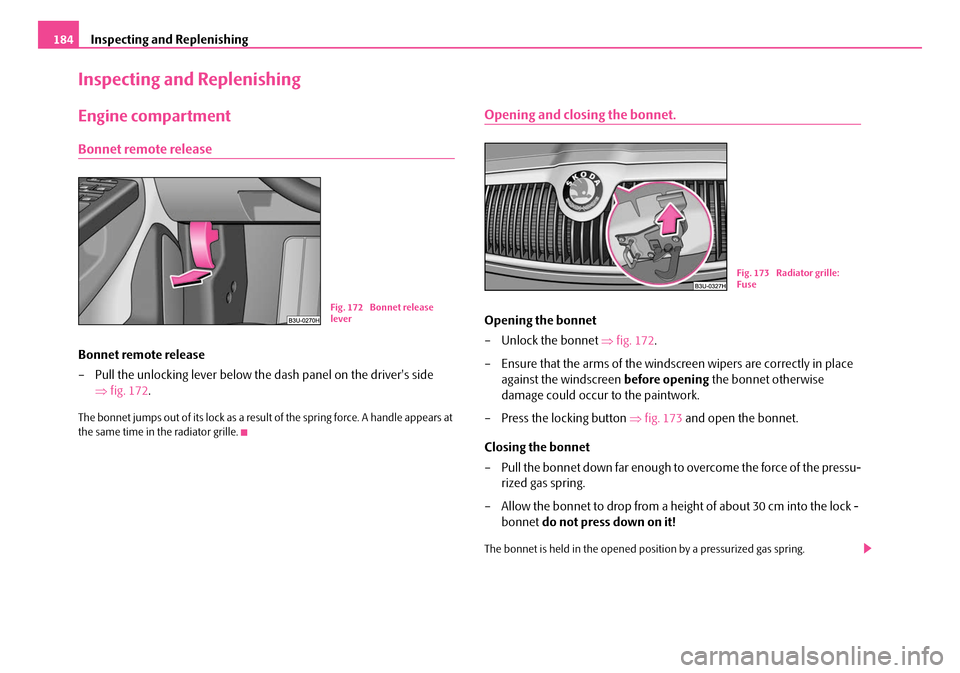
Inspecting and Replenishing
184
Inspecting and Replenishing
Engine compartment
Bonnet remote release
Bonnet remote release
– Pull the unlocking lever below the dash panel on the driver's side
⇒ fig. 172 .
The bonnet jumps out of its lock as a result of the spring force. A handle appears at
the same time in the radiator grille.
Opening and closing the bonnet.
Opening the bonnet
– Unlock the bonnet ⇒fig. 172 .
– Ensure that the arms of the windsc reen wipers are correctly in place
against the windscreen before opening the bonnet otherwise
damage could occur to the paintwork.
– Press the locking button ⇒fig. 173 and open the bonnet.
Closing the bonnet
– Pull the bonnet down far enough to overcome the force of the pressu- rized gas spring.
– Allow the bonnet to drop from a height of about 30 cm into the lock -
bonnet do not press down on it!
The bonnet is held in the opened po sition by a pressurized gas spring.
Fig. 172 Bonnet release
lever
B1Z-0042HB1Z-0042HFig. 173 Radiator grille:
Fuse
NKO B5 20.book Page 184 Friday, March 2, 2007 1:46 PM
Page 186 of 259
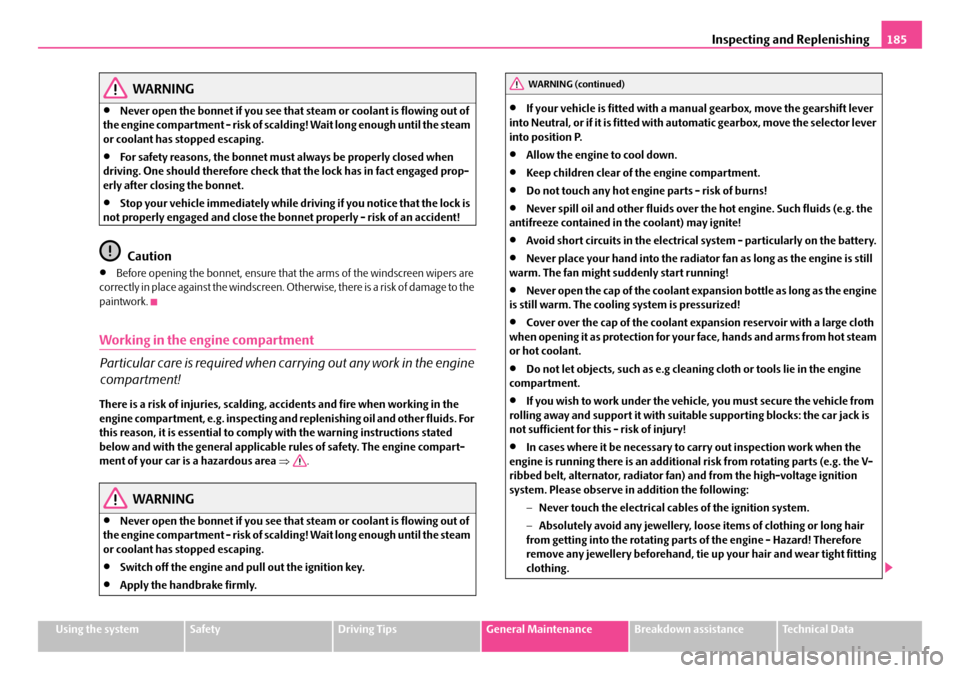
Inspecting and Replenishing185
Using the systemSafetyDriving TipsGeneral MaintenanceBreakdown assistanceTechnical Data
WARNING
•Never open the bonnet if you see that steam or coolant is flowing out of
the engine compartment - risk of scaldi ng! Wait long enough until the steam
or coolant has stopped escaping.
•For safety reasons, the bonnet must always be properly closed when
driving. One should therefore check that the lock has in fact engaged prop-
erly after closing the bonnet.
•Stop your vehicle immediately while driv ing if you notice that the lock is
not properly engaged and close the bonne t properly - risk of an accident!
Caution
•Before opening the bonnet, ensure that the arms of the windscreen wipers are
correctly in place against the windscreen. Otherwise, there is a risk of damage to the
paintwork.
Working in the engine compartment
Particular care is required when carrying out any work in the engine
compartment!
There is a risk of injuries, scalding, accidents and fire when working in the
engine compartment, e.g. inspecting and replenishing oil and other fluids. For
this reason, it is essential to comply with the warning instructions stated
below and with the general applicable rules of safety. The engine compart-
ment of your car is a hazardous area ⇒ .
WARNING
•Never open the bonnet if you see that steam or coolant is flowing out of
the engine compartment - risk of scaldi ng! Wait long enough until the steam
or coolant has stopped escaping.
•Switch off the engine and pull out the ignition key.
•Apply the handbrake firmly.
•If your vehicle is fitted with a ma nual gearbox, move the gearshift lever
into Neutral, or if it is fitted with automatic gearbox, move the selector lever
into position P.
•Allow the engine to cool down.
•Keep children clear of the engine compartment.
•Do not touch any hot engine parts - risk of burns!
•Never spill oil and other fluids over the hot engine. Such fluids (e.g. the
antifreeze contained in the coolant) may ignite!
•Avoid short circuits in the electrical system - particularly on the battery.
•Never place your hand into the radiator fan as long as the engine is still
warm. The fan might suddenly start running!
•Never open the cap of the coolant expa nsion bottle as long as the engine
is still warm. The cooling system is pressurized!
•Cover over the cap of the coolant expansion reservoir with a large cloth
when opening it as protection for your face, hands and arms from hot steam
or hot coolant.
•Do not let objects, such as e.g cleaning cloth or tools lie in the engine
compartment.
•If you wish to work under the vehicle, you must secure the vehicle from
rolling away and support it with suitable supporting blocks: the car jack is
not sufficient for this - risk of injury!
•In cases where it be necessary to carry out inspection work when the
engine is running there is an additional risk from rotating parts (e.g. the V-
ribbed belt, alternator, radiator fan) and from the high-voltage ignition
system. Please observe in addition the following:
−Never touch the electrical cabl es of the ignition system.
− Absolutely avoid any jewellery, loose items of clothing or long hair
from getting into the rotating parts of the engine - Hazard! Therefore
remove any jewellery beforehand, tie up your hair and wear tight fitting
clothing.
WARNING (continued)
NKO B5 20.book Page 185 Friday, March 2, 2007 1:46 PM
Page 187 of 259
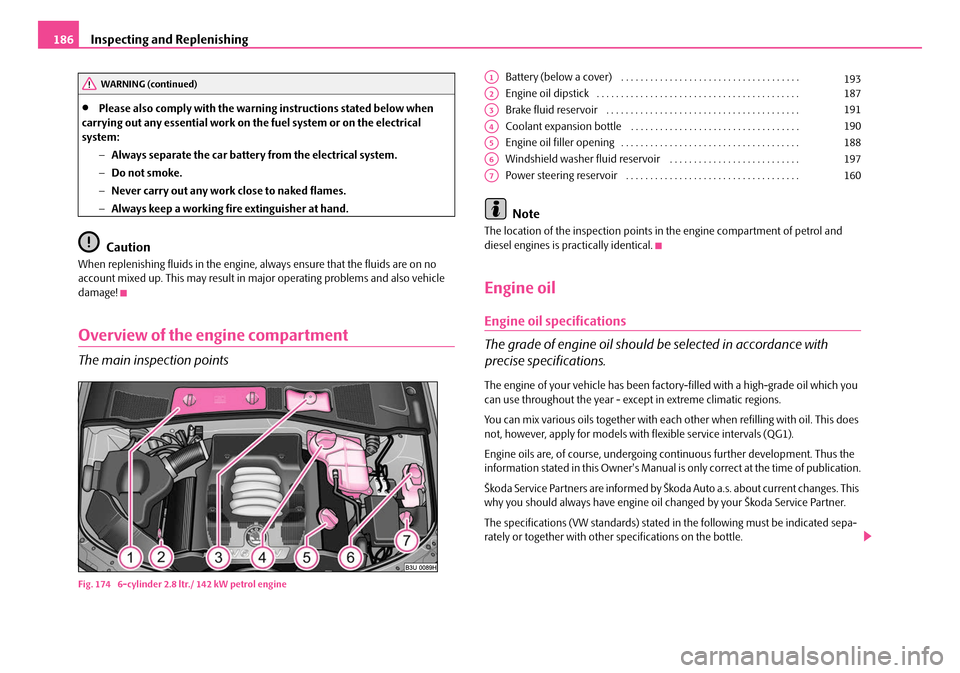
Inspecting and Replenishing
186
•Please also comply with the warnin g instructions stated below when
carrying out any essential work on the fuel system or on the electrical
system:
−Always separate the car batter y from the electrical system.
− Do not smoke.
− Never carry out any work close to naked flames.
− Always keep a working fire extinguisher at hand.
Caution
When replenishing fluids in the engine, always ensure that the fluids are on no
account mixed up. This may result in major operating problems and also vehicle
damage!
Overview of the engine compartment
The main inspection points
Fig. 174 6-cylinder 2.8 ltr./ 142 kW petrol engine
Battery (below a cover) . . . . . . . . . . . . . . . . . . . . . . . . . . . . . . . . . . . . .
Engine oil dipstick . . . . . . . . . . . . . . . . . . . . . . . . . . . . . . . . . . . . . . . . . .
Brake fluid reservoir . . . . . . . . . . . . . . . . . . . . . . . . . . . . . . . . . . . . . . . .
Coolant expansion bottle . . . . . . . . . . . . . . . . . . . . . . . . . . . . . . . . . . .
Engine oil filler opening . . . . . . . . . . . . . . . . . . . . . . . . . . . . . . . . . . . . .
Windshield washer fluid reservoir . . . . . . . . . . . . . . . . . . . . . . . . . . .
Power steering reservoir . . . . . . . . . . . . . . . . . . . . . . . . . . . . . . . . . . . .
Note
The location of the inspection points in the engine compartment of petrol and
diesel engines is practically identical.
Engine oil
Engine oil specifications
The grade of engine oil should be selected in accordance with
precise specifications.
The engine of your vehicle has been factor y-filled with a high-grade oil which you
can use throughout the year - except in extreme climatic regions.
You can mix various oils together with each other when refilling with oil. This does
not, however, apply for models with flexible service intervals (QG1).
Engine oils are, of course, undergoing co ntinuous further development. Thus the
information stated in this Owner's Manual is only correct at the time of publication.
Škoda Service Partners are informed by Škoda Auto a.s. about current changes. This
why you should always have engine oil changed by your Škoda Service Partner.
The specifications (VW standards) stated in the following must be indicated sepa-
rately or together with other specifications on the bottle.
WARNING (continued)A1193A2187
A3191
A4190
A5188
A6197
A7160
NKO B5 20.book Page 186 Friday, March 2, 2007 1:46 PM
Page 188 of 259

Inspecting and Replenishing187
Using the systemSafetyDriving TipsGeneral MaintenanceBreakdown assistanceTechnical Data
Engine oil specifications for vehicles with fixed service intervals (QG2)
Engine oil specifications for models with flexible service intervals (QG1)
Caution
Only the above-mentioned oils
may be used on vehicles with flexible service inter-
vals (QG1). We recommend always refilling with oil of the same specification since
this will maintain the properties of the oil. In exceptional cases, you must top up
only once engine oil complying with Sp ecification VW 502 00 (only for petrol
engines) or Specification VW 505 01 (only for diesel engines) to maximum 0.5 litres.
You must not use other engine oi ls - risk of engine damage!
Note
•Before a long drive we recommend th at you purchase and carry with you
engine oil which complies with the specif ication for your vehicle. Consequently,
you will always have the correct engine oil for refilling.
•We recommend using a preservative from the Škoda original accessories
offered by your Škoda dealer.
•For further information - see Service shedule.
Check engine oil level
The dipstick indicates the le vel of oil in the engine.
Checking the oil level
– Park the vehicle on a horizontal surface.
– Switch the engine off.
– Open the bonnet ⇒ in “Working in the engine compartment” on
page 185.
– Wait a few minutes and pull out the oil dipstick.
– Wipe off the dipstick with a clean cloth and insert it again fully.
Specification
Petrol enginesVW 501 01
VW 502 00
VW 504 00
Diesel engines
VW 505 00a)
VW 505 01b)
VW 507 00c)
a)Not valid for PD engine (a unit injector engine) and engine with DPF (diesel particle
filter).
b)Not valid for engine with DPF (diesel pa rticle filter). Further information ⇒page 160,
“Diesel particle filter* (diesel engine)”.
c)This does not apply for PDi engi nes (a unit injection engine).
Specification
Petrol enginesVW 503 00
VW 504 00
Diesel enginesVW 506 01a)
VW 507 00
a)Not valid for engine with DPF (diesel pa rticle filter). Further information ⇒page 160,
“Diesel particle filter* (diesel engine)”.
Fig. 175 Dipstick
NKO B5 20.book Page 187 Friday, March 2, 2007 1:46 PM
Page 189 of 259

Inspecting and Replenishing
188
– After this, once again withdraw the dipstick and read off the oil level ⇒page 187, fig. 175 .
Oil level within range
– You must not top up the oil.
Oil level within range
–You may top up the oil. It is possible that the oil level may then be
within range after doing this.
Oil level within range
–You must top up the oil ⇒page 188. It is sufficient, once this is done,
to keep the oil level is within range .
It is normal for the engine to consume oil. The oil cons umption may be as much as
0.5 l/1 000 km depending on your style of driving and the conditions under which
you operate your vehicle. The oil consumpt ion may be slightly higher than this
during the first 5 000 kilometres.
One should therefore check the oil level at regular intervals, preferably every time
after the fuel tank is filled or after driving for long stretches.
We recommend maintaining the oil level within the range if the engine has been
operating at high loads, for example during a lengthy motorway trip during the
summer months, towing a trailer or negotiating a high mountain pass, but not
above this .
The warning light in the instrument cluster will indicate whether the oil level is too
low ⇒page 27, “Engine oil ”. In this case, check the oil level as soon as possible.
Top up with an approp riate quantity of oil.
WARNING
Read and observe the warning notes ⇒page 185, “Working in the engine
compartment” before working in the engine compartment.
Caution
•The oil level must on no account ex tend beyond the range . Danger of
damaging the catalytic converter.
•Do not continue your journey if for some reason it is not possible under the
conditions prevailing to top up with oil. Switch the engine off and obtain profes-
sional assistance from a specialist garage, otherwise it could lead to severe engine
damage.
Replenishing engine oil
– Inspect the oil level ⇒page 187.
– Unscrew the cap of the engine oil filler opening.
– Pour in a suitable grade of oil in portions of 0.5 litres ⇒page 186,
“Engine oil specifications”.
– Inspect the oil level ⇒page 187.
– Carefully screw on the cap of the filler opening and push the dipstick in fully.
WARNING
•Avoid dripping oil onto hot parts of the engine when topping up will oil -
a risk of fire!
•Read and observe the warning notes ⇒page 185, “Working in the engine
compartment” before working in the engine compartment.
For the sake of the environment
The oil level must on no account be above the range ⇒page 187, fig. 175. Oil
will otherwise be drawn in through the cr ankcase ventilation and may pass through
the exhaust system to atmosphere. The oi l may combust in the catalytic converter
and damage it.
Aa
Ab
Aa
Ac
Ab
Aa
Aa
Aa
NKO B5 20.book Page 188 Friday, March 2, 2007 1:46 PM
Page 190 of 259
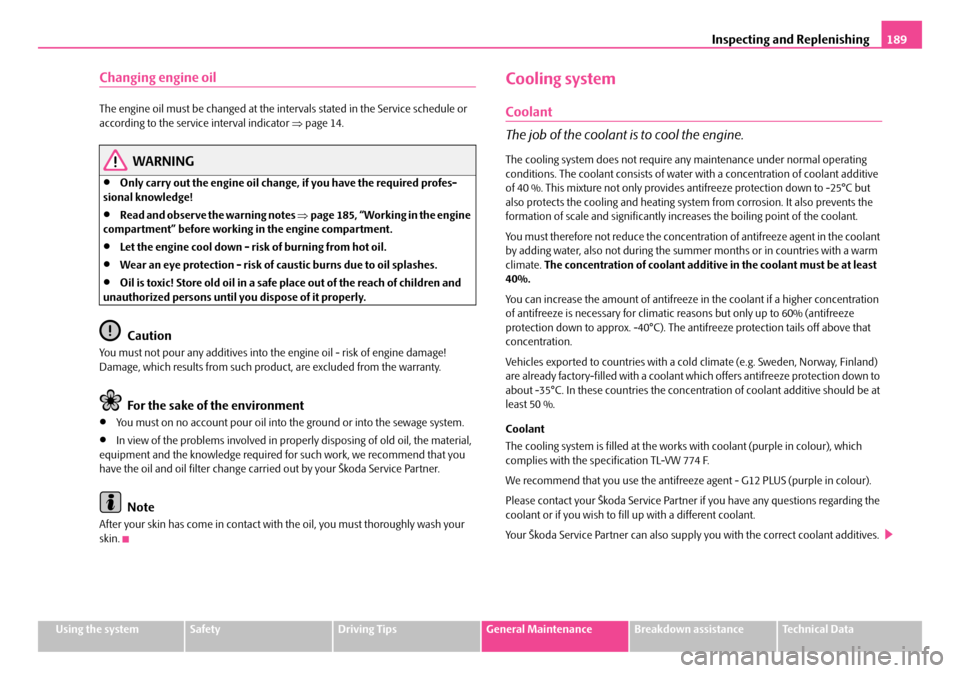
Inspecting and Replenishing189
Using the systemSafetyDriving TipsGeneral MaintenanceBreakdown assistanceTechnical Data
Changing engine oil
The engine oil must be changed at the intervals stated in the Service schedule or
according to the service interval indicator ⇒page 14.
WARNING
•Only carry out the engine oil change, if you have the required profes-
sional knowledge!
•Read and observe the warning notes ⇒page 185, “Working in the engine
compartment” before working in the engine compartment.
•Let the engine cool down - risk of burning from hot oil.
•Wear an eye protection - risk of caustic burns due to oil splashes.
•Oil is toxic! Store old oil in a safe place out of the reach of children and
unauthorized persons until you dispose of it properly.
Caution
You must not pour any additives into th e engine oil - risk of engine damage!
Damage, which results from such produc t, are excluded from the warranty.
For the sake of the environment
•You must on no account pour oil into the ground or into the sewage system.
•In view of the problems involved in prop erly disposing of old oil, the material,
equipment and the knowledge required for such work, we recommend that you
have the oil and oil filter change carried out by your Škoda Service Partner.
Note
After your skin has come in contact with the oil, you must thoroughly wash your
skin.
Cooling system
Coolant
The job of the coolant is to cool the engine.
The cooling system does not require an y maintenance under normal operating
conditions. The coolant consist s of water with a concentration of coolant additive
of 40 %. This mixture not only provides antifreeze protection down to -25°C but
also protects the cooling and heating system from corrosion. It also prevents the
formation of scale and significantly increases the boiling point of the coolant.
You must therefore not reduce the concentration of antifreeze agent in the coolant
by adding water, also not during the su mmer months or in countries with a warm
climate. The concentration of coolant additive in the coolant must be at least
40%.
You can increase the amount of antifreeze in the coolant if a higher concentration
of antifreeze is necessary for climatic reasons but only up to 60% (antifreeze
protection down to approx. -40°C). The an tifreeze protection tails off above that
concentration.
Vehicles exported to countries with a co ld climate (e.g. Sweden, Norway, Finland)
are already factory-filled with a coolant which offers antifreeze protection down to
about -35°C. In these countries the concentr ation of coolant additive should be at
least 50 %.
Coolant
The cooling system is filled at the works with coolant (purple in colour), which
complies with the specification TL-VW 774 F.
We recommend that you use the antifreeze agent - G12 PLUS (purple in colour).
Please contact your Škoda Se rvice Partner if you have any questions regarding the
coolant or if you wish to fill up with a different coolant.
Your Škoda Service Partner can also suppl y you with the correct coolant additives.
NKO B5 20.book Page 189 Friday, March 2, 2007 1:46 PM
Page 191 of 259
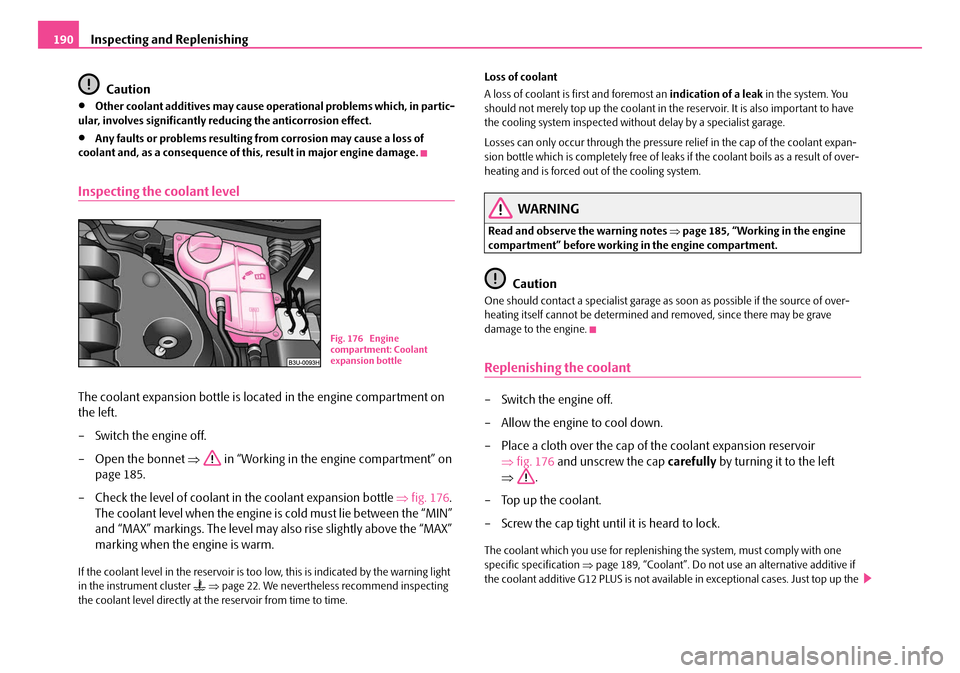
Inspecting and Replenishing
190
Caution
•Other coolant additives may cause operational problems which, in partic-
ular, involves significantly reducing the anticorrosion effect.
•Any faults or problems resulting from corrosion may cause a loss of
coolant and, as a consequence of th is, result in major engine damage.
Inspecting the coolant level
The coolant expansion bottle is located in the engine compartment on
the left.
– Switch the engine off.
– Open the bonnet ⇒ in “Working in the engine compartment” on
page 185.
– Check the level of coolant in the coolant expansion bottle ⇒fig. 176 .
The coolant level when the engine is cold must lie between the “MIN”
and “MAX” markings. The level may also rise slightly above the “MAX”
marking when the engine is warm.
If the coolant level in the reservoir is too low, this is indicated by the warning light
in the instrument cluster ⇒ page 22. We nevertheless recommend inspecting
the coolant level directly at th e reservoir from time to time. Loss of coolant
A loss of coolant is first and foremost an
indication of a leak in the system. You
should not merely top up the coolant in the reservoir. It is also important to have
the cooling system inspected without delay by a specialist garage.
Losses can only occur through the pressure relief in the cap of the coolant expan-
sion bottle which is completely free of leaks if the coolant boils as a result of over-
heating and is forced out of the cooling system.
WARNING
Read and observe the warning notes ⇒page 185, “Working in the engine
compartment” before working in the engine compartment.
Caution
One should contact a specialist garage as soon as possible if the source of over-
heating itself cannot be determined and removed, since there may be grave
damage to the engine.
Replenishing the coolant
– Switch the engine off.
– Allow the engine to cool down.
– Place a cloth over the cap of the coolant expansion reservoir ⇒fig. 176 and unscrew the cap carefully by turning it to the left
⇒ .
– Top up the coolant.
– Screw the cap tight until it is heard to lock.
The coolant which you use for replenishing the system, must comply with one
specific specification ⇒page 189, “Coolant”. Do not use an alternative additive if
the coolant additive G12 PLUS is not available in exceptional cases. Just top up the
B1Z-0042HB1Z-0042H
Fig. 176 Engine
compartment: Coolant
expansion bottle
NKO B5 20.book Page 190 Friday, March 2, 2007 1:46 PM